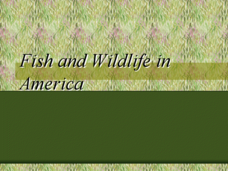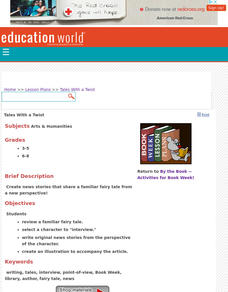Global Oneness Project
The Man and the Wolf
Human attitudes toward the big bad wolf come into focus in a photo essay that asks viewers to consider their own feelings about the endangered species.
Usborne Publishing Ltd
Little Red Riding Hood Worksheet
Designed to be used after a reading of The Little Red Riding Hood, this activity asks kids to match thought bubbles with pictures, to order events, and to form the past tense of selected verbs.
Curated OER
Through the Eyes of the Big Bad Wolf
Imagine how the wolf would tell the tale of Little Red Riding Hood or The Three Little Pigs. Young writers re-imagine classic tales by adopting the point of view of another character in the story. After reading models like The True Story...
Curated OER
The Big, Bad Wolf
Seventh graders analyze the stereotyping of wolves in children's literature. They compare stereotypes and facts about wolves. They rewrite a fairy tale from the wolf's point of view.
Curated OER
Who's Afraid of the Big, Bad Wolf?
Students, at the advanced beginner to low intermediate ESL levels, demonstrate comprehension of the play or story, "Little Red Riding Hood." They construct interviews based on knowledge of the characters in the play Little Red Riding Hood.
Curated OER
The Big Bad Wolf
Tenth graders analyze the popular fairy tale "The Three Little Pigs" for inaccurate references to wolves. They write a story (or compose a song) that correctly depicts the characteristics, traits and predator-prey relationship of a wolf.
Curated OER
Little Red Riding Hood
In this Little Red Riding Hood activity, students fill in the blanks to the story with the words given and complete a word search. Students complete 2 activities total.
Curated OER
Thesis statements: The Six Basic Claim Types
Evaluative or Analogical? The wolf in the story of "The Three Little Pigs" and the wolf in "Red Riding Hood" represent what can happen to the unprepared. Despite his defeat in the end, the Big Bad Wolf is a good example for kids because...
Curated OER
Little Red Riding Hood and the Wolf
In this Little Red Riding Hood and the Wolf worksheet, students watch a video of Little Red Riding Hood and the Wolf and complete multiple choice, true and false, fill in the blank, and picture identification activities. Students...
Curated OER
The Wolf's Tale: Louise Cooper: Extension 2
For this wolves worksheet, students complete 3 pages of extension activities pertaining to wolves, their endangered status, and fear of wolves in history and literature. This is intended to be an extension after reading The Wolf's Tale...
Curated OER
The ea and ear sounds
Focus on the /ea/ and /ear/ sounds. Learners complete three sentences by adding the appropriate ea word from a word bank, re-writing each sentence. Then, they read an excerpt from Little Red Riding Hood and find all the words with...
Curated OER
I'm a Changed Pig - Personal Narrative
Young writers explore character arcs, conflict, and narrative in this complete and ready-to-use lesson plan from Scholastic. As a class read The Three Little Wolves and the Big Bad Pig and discuss the dramatic change the pig undergoes...
Curated OER
I'm a Changed Pig
Introduce your class to fairy tales with this instructional activity. After reading the fractured fairy tale, "The Three Little Wolves and the Big Bad Pig," third, fourth, and fifth graders write a personal narrative as a response to the...
Curated OER
Turning Tomato
Did you know that tomatoes are the world’s most popular fruit? Did you know that tomatoes are related to the deadly nightshade plant? Using red plates and brads, your researchers record tomato facts on a pie chart and create a Turning...
Curated OER
Reading
Students are introduced to various types of folk tales. During a read-aloud, they predict what they believe is going to happen next and practice following the story line. To end the lesson, they answer comprehension questions and...
Curated OER
Mock Trial
Students rewrite a traditional fairy tale to represent the viewpoint of the villain. They participate in a mock trial of that villain in which all regular court participants (judge, jury, defendant, witnesses, plaintiff, etc) play roles.
Curated OER
Fish and Wildlife in America
Some of the details of the use of wildlife as food and crop resources are given at the beginning of this slideshow. Next, the historical problems with wildlife are explained, as are some mistakes that have been made leading to extinction...
Curated OER
Tales with a Twist
Your authors create news stories that share a familiar fairy tale from a new perspective. They review a familiar fairy tale, select a character to "interview," and write original news stories from the perspective of that character.
Florida Center for Reading Research
Fluency: Connected Text, Express It!
Partners practice reading fluency by reciting sentence strips to each other with proper expression and intonation. Partner A chooses a strip at random and reads it silently, then aloud with expression. Partner B reads the same sentence...
Curated OER
Animal Signs
Students discuss the many different types of animal signs that can be used to identify and track animals. They participate in an hands-on activity in which they examine tracks, trails, homes, territory markings, and even "scat" left by...
Curated OER
Understand the Difference Between Fiction and Non-Fiction
In this fiction and non-fiction worksheet, students cut out 9 sentence strips, read them, and classify each of them as fact or fiction.
Curated OER
The better to eat you, dear!
Students practice various strategies for fluent, expressive reading. After reviewing sentence structure, students choose an appropriate leveled book to read with their partner. They are assessed on their reading fluency and reading...























